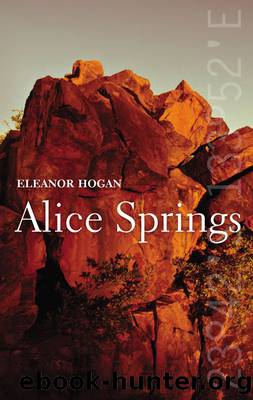Alice Springs by Hogan Eleanor;

Author:Hogan, Eleanor;
Language: eng
Format: epub
Publisher: University of New South Wales Press
Local elder Betty Pearce suggests the combined impact of pastoralism and the missions in central Australia was to destabilise and erode Aboriginal family and social order, with the result that no one these days has a âproper structure on how to deal with the violence from a traditional Aboriginal perspective, theyâre dealing with it from a white man perspectiveâ. Born in 1932 to a Wambaya woman and a central Arrernte man of mixed descent, Pearce lived on various cattle stations in the Territory with her family while attending school in Alice Springs, giving her insight into both cultures. She recalls how, before the âwhite man cameâ, women were âbossesâ of their own sphere of law. At the age of eleven, she was invited to see the women enact a punishment to a man who had interfered with traditional law, and she later saw a woman who had been punished because sheâd âinterfered with the male sideâ. But the balance of this world was soon disturbed:
By the time I was thirteen, that rule or law was taken away because the women were getting stronger while the men were working on the station. The women were having to take more care of the children, and of the older children and the older boys, because the men werenât around. So the women were stronger and they started making their strength felt, and then it changed.
Once âthe white system was predominatingâ on the stations, Aboriginal people would say âwhite manâs bossâ: they did not wish to punish people under two laws.
Pearce also thinks that the creation of the stolen generations, in which the churches and the missions were strongly involved in the Territory, âmust have something to do withâ the prevalence of violence in contemporary central Australia. The removal of Aboriginal children from their parents was practised widely across the Territory from the early 20th century onwards, particularly in response to fears of miscegenation. Recent statistics support Pearceâs conjecture: in remote areas Indigenous mothers removed from their natural families during childhood have nearly three times the risk of being victims of violence as those who have not been removed from their natural families. Like other commentators, Pearce blames the removal of children from their parents for the erosion of psychosocial development and skills, and for Aboriginal children, a sense of having fallen between two cultures without forming an effective identity within either and the confusion of the âtraditional Aboriginal way, the confusion of the Christian wayâ. She comments: âSo they were a lost people, and there has to be some kind of frustration there. A feeling of disempowerment. And then that feeling comes out ⦠People have glossed over it and that has to be addressed before you can say violence is unacceptable.â
Pearce observes that violence was used as a sanction within traditional culture before European contact, but that it was âcontrolled violenceâ: âIf there was a punishment, the punishment was over and done with. It was done straightaway by the right people. It did not carry on and on.
Download
This site does not store any files on its server. We only index and link to content provided by other sites. Please contact the content providers to delete copyright contents if any and email us, we'll remove relevant links or contents immediately.
Full Circle by Michael Palin(2781)
Cuba by Lonely Planet(2191)
Birds of New Guinea by Pratt Thane K.; Beehler Bruce M.; Anderton John C(1915)
Lonely Planet Australia by Lonely Planet(1681)
Beyond the Coral Sea by Michael Moran(1628)
Discover Australia by Lonely Planet(1589)
Kings Cross by Louis Nowra(1465)
Lonely Planet Maldives (Travel Guide) by Planet Lonely & Masters Tom(1432)
Borneo Travel Guide by Lonely Planet(1355)
Ten Degrees of Reckoning: The True Story of a Family's Love and the Will to Survive by Hester Rumberg(1348)
Lonely Planet Australia (Travel Guide) by Lonely Planet & Lonely Planet(1310)
Lonely Planet South Australia & Northern Territory by Lonely Planet(1227)
Lonely Planet Pocket Hobart by Lonely Planet(1161)
The Sex Lives of Cannibals: Adrift in the Equatorial Pacific by J. Maarten Troost(1135)
Kiwi Tracks by Lonely Planet(1083)
Lonely Planet Australia (Travel Guide) by Lonely Planet(1032)
Epic Hikes of the World by Lonely Planet(1002)
Personal 03 - Personal Secrets by K.C. Wells(991)
East Coast Australia by Lonely Planet(959)
